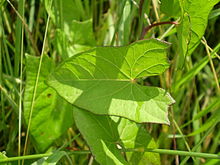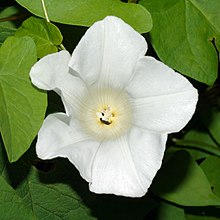Real bindweed
| Real bindweed | ||||||||||||
|---|---|---|---|---|---|---|---|---|---|---|---|---|

True bindweed ( Calystegia sepium subsp. Sepium ) |
||||||||||||
| Systematics | ||||||||||||
|
||||||||||||
| Scientific name | ||||||||||||
| Calystegia sepium | ||||||||||||
| ( L. ) R.Br. |
The Calystegia sepium ( Calystegia sepium ) is a plant of the genus calystegia ( Calystegia ) within the family of wind plants (Convolvulaceae).
description
Vegetative characteristics
The real bindweed grows as a climbing, deciduous, perennial herbaceous plant . Creeping rhizomes are formed as persistence organs. It has green, winding stems . The alternate leaves are arranged in a petiole and a leaf blade. The leaf blade is simple. There are no stipules .
Generative characteristics
The flowering period is between May and September. Below the flower stalks, there are two distinct, green bracts on the outside . The hermaphrodite flower is radially symmetrical and five-fold with a double flower envelope . The white, funnel-shaped corolla has a diameter of 5 to 7 centimeters. The ovary is on top.
There are fruit capsules formed. The egg-shaped seeds are 4 to 6 millimeters long and 25 to 30 mg in weight.
The number of chromosomes is 2n = 22 or 24.
ecology
The true bindweed is a hemicryptophyte and a twining climber . The end sections of the runners form short tubers. The vegetative reproduction takes place through the widely creeping rhizomes or fragments thereof, for example through voles and gardening. It is rooted up to 70 centimeters deep.
The bindweed is one of the pioneering creeping plants because of its deep creeping, underground rhizomes . The tips of the shoot axes carry out circular search movements (one revolution in 1 hour 45 minutes) when viewed from above, counter-clockwise ( left-hand winder ) in order to be able to wind up on a suitable surface.
The flowers are also open at night, but closed in cloudy weather. The pollination is effected by moths ( moth ) and hoverflies . The main pollinator is the wind swarm ( Herse convolvuli ) with its 8 centimeter long trunk; it is a migratory butterfly that flies to us from southern Europe every year . Also, self-pollination is successful.
When dry , the fruits are capsule fruits that burst open with longitudinal cracks and are enveloped by the bracts. They are usually shaken out by the wind or washed out by flooding; With this swimming spread, the swimming time can last up to 33 months. Fruit ripening is from June to September.
Occurrence
The true bindweed is widespread in the temperate to subtropical areas of the world.
The real bindweed can be found almost everywhere in Germany, Austria and Switzerland. Here it mostly grows in hedges or dense undergrowth. In Central Europe it is a character species of the order Convolvuletalia sepium, but also occurs in societies of the order Glechometalia or the associations Arction or Salicion albae. In the Allgäu Alps, it rises to an altitude of 900 meters.
ingredients
The True bindweed contains calystegines which are polyhydroxylated nortropane - alkaloids , which differ in their biosynthesis derived from tropane alkaloid biosynthesis. Calystegin A3 and B2 are found in all plant organs.
Systematics
It was first published in 1753 under the name ( Basionym ) Convolvulus sepium by Carl von Linné . The new combination to Calystegia sepium (L.) R.Br. was published by Robert Brown .
Depending on the author, there are several subspecies of Calystegia sepium :
- Calystegia sepium subsp. americana (Sims) Brummitt : It is widespread from Canada to the USA and is also found in the Azores , Tristan da Cunha and South Africa .
- Calystegia sepium subsp. angulata Brummitt : It occurs in Canada and the USA.
- Calystegia sepium subsp. appalachiana Brummitt : It occurs in North America from Minnesota to New Brunswick and North Carolina .
- Calystegia sepium subsp. baltica Rothm. : It has pale pink colored flowers, hairy petioles, in bushes, reed edges and is found in the Baltic region especially on the Baltic Sea.
- Calystegia sepium subsp. binghamiae (Greene) Brummitt : It only occurred in western California , but is now regarded as a separate species Calystegia binghamiae (Greene) Brummitt .
- Calystegia sepium subsp. erratica Brummitt : It occurs in the USA.
- Calystegia sepium subsp. limnophila (Greene) Brummitt : It is widespread from New Brunswick in Canada via the USA to northwestern Mexico and Peru .
- Calystegia sepium subsp. roseata Brummitt : It occurs in Northern and Western Europe , in Australia , in New Zealand and on Easter Island .
- Calystegia sepium (L.) R.Br. subsp. sepium (Syn .: Convolvulus maritimus Gouan , Convolvulus major Gilib. , Volvulus sepium (L.) Medic. , Convolvulus laetus Salisb. , Calystegia maximiliana Nees , Convolvulus maximiliani Nees , Calystegia sepium var. maritima (Gouan) Choisy , Convolvulus ex Choisy , Calystegia obtusa Pomel , Convolvulus sepincola St.-Lag. , Convolvulus acutifolius Phil. Ex Reiche , Convolvulus nashii House ): It is distributed from Macaronesia over the Mediterranean and Europe to northwestern China and Afghanistan . It has white flowers and thrives in central Europe in hedges and on fences.
- Calystegia sepium subsp. spectabilis Brummitt : It occurs from Siberia to Japan .
Common names
The other German-language trivial names exist or existed for the real bindweed: Bärwinde ( Silesia ), Beglerseil, Brunestock (Silesia), Dagblöme ( East Frisia ), Wiss Glockenblockelblume uf den Zunen ( Middle High German ), Glockenblum (Middle High German), Glockenplum (Middle High German), White bellflowers, Glogga ( St. Gallen near Sargans ), Haagglocke ( Aargau ), hedgehog (Silesia), Pisspott (East Frisia), Pisspottje (East Frisia), Rägabluame (St. Gallen), Rägaglogge (St. Gallen), rain flower ( Bern , Lucerne , Aargau), Stockwinn ( Eifel , Altenahr ), Theeköppke (East Friesland), Tunnwinn ( Mecklenburg ), Tunried (Mecklenburg), Wängd ( Transylvania ), Grote Wedewinde (Middle High German), Grote Wedewindeblomen (Middle High German), Grote Wedewindeglocken (Middle High German), Wewinne (Götting.), Wewinneke (Götting.), Groß Wind, Glatt Wind, Winda, Winde, Windekrut, Winderling, White Winde (Silesia), White Windbells, Windla (St. Gallen near Werdenberg ), Windr ose (St. Gallen near Sargans), Wrange, fence bells (Eifel), fence vines ( Salzburg ) and winch.
literature
- Maria Teresa Della Beffa: The great natural guide herbs . Kaiser, Klagenfurt 2005, ISBN 3-7043-1314-9 .
- Dietmar Aichele: What is blooming there? Kosmos, Stuttgart 2005, ISBN 3-440-10212-2 .
- Ruprecht Düll , Herfried Kutzelnigg : Pocket dictionary of plants in Germany and neighboring countries. The most common Central European species in portrait . 7th, corrected and enlarged edition. Quelle & Meyer, Wiebelsheim 2011, ISBN 978-3-494-01424-1 .
Individual evidence
- ↑ a b c Erich Oberdorfer : Plant-sociological excursion flora for Germany and neighboring areas . With the collaboration of Angelika Schwabe and Theo Müller. 8th, heavily revised and expanded edition. Eugen Ulmer, Stuttgart (Hohenheim) 2001, ISBN 3-8001-3131-5 , pp. 772 .
- ↑ Erhard Dörr, Wolfgang Lippert : Flora of the Allgäu and its surroundings. Volume 2, IHW, Eching 2004, ISBN 3-930167-61-1 , p. 358.
- ↑ Yvonne Sichhart, dissertation 2003 at the Martin Luther University Halle-Wittenberg: Genes, enzymes and products of calystegin formation in Calystegia sepium (L.) R. Br.
- ↑ a b c d e f g h i j k Rafaël Govaerts (Ed.): Calystegia sepium. In: World Checklist of Selected Plant Families (WCSP) - The Board of Trustees of the Royal Botanic Gardens, Kew . Retrieved January 4, 2020.
- ^ Georg August Pritzel , Carl Jessen : The German folk names of plants. New contribution to the German linguistic treasure. Philipp Cohen, Hanover 1882, page 109 f. ( online ).
Web links
- Real bindweed. In: FloraWeb.de.
- Real bindweed . In: BiolFlor, the database of biological-ecological characteristics of the flora of Germany.
- Calystegia sepium (L.) R. Br. In: Info Flora , the national data and information center for Swiss flora . Retrieved February 1, 2016.
- Distribution in the northern hemisphere
- Thomas Meyer: Bindweed data sheet with identification key and photos at Flora-de: Flora von Deutschland (old name of the website: Flowers in Swabia )
- Flower structure in detail.







